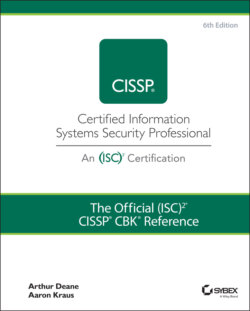Читать книгу The Official (ISC)2 CISSP CBK Reference - Leslie Fife, Aaron Kraus - Страница 145
U.S. National Institute of Standards and Technology
ОглавлениеThrough a hierarchy of publications, the National Institute of Standards and Technology provides direction to U.S. government agencies in implementing information security practices. In the current incarnation, the Risk Management Framework (RMF) provides a structured analytical process to identify, control, evaluate, and improve the organization's information security controls. Documented in NIST Special Publication 800-37, “Guide for Applying the Risk Management Framework to Federal Information Systems,” it prescribes a six-step process through which the federal government manages the risks of its information systems; the six steps are pictured in Figure 1.8. Though the steps in this framework are tailored to government agencies, they are widely applicable within just about every industry.
The first step of the NIST RMF involves categorizing all information systems based on the potential impact to the organization due to the loss of confidentiality, integrity, or availability. Implied in this process is that the organization must have a comprehensive inventory of systems to apply the categorization standard. Once security categorization has been performed, a baseline set of controls must be selected based on the identified categorization and impact.
FIGURE 1.8 NIST Risk Management Framework
Once the system has been categorized and baseline controls are selected, the controls must be implemented and monitored to ensure that they “are implemented correctly, operating as intended, and producing the desired outcome with respect to meeting the security requirements for the system.” This will produce a set of documents certifying the technical application of the controls.
After categorizing information systems, selecting and implementing controls, and assessing the effectiveness of those controls, organizational leadership then makes a formal decision whether to authorize the use of the system. This decision is based on the ability of the controls to operate the system within the organization's risk tolerance. Finally, the organization must continuously monitor the effectiveness of the controls over time to ensure that the ongoing operation of the system occurs within the organization's risk tolerance.
While focused on the computing activities of the U.S. government, the NIST standards and guidelines have had a pervasive effect on the security community because of their broad scope, their availability in the public domain, and the inclusion of industry, academic, and other standards organizations in the development of the standards. Further, the NIST standards often set the expectations for security practice that are placed on other regulated industries. This is most clearly shown in HIPAA legislation, where healthcare organizations must demonstrate that their controls align with the NIST security practice. Due to its broad reference, the NIST RMF is an important part of the CISSP CBK.
TIP NIST 800-30, “Guide for Conducting Risk Assessments,” and the NIST Cybersecurity Framework (discussed in the “Security Control Frameworks” section) both provide practical guidance to help the CISSP frame, present, and inform management decisions about risk.
